Front wheel TOYOTA PRIUS C 2012 NHP10 / 1.G Owners Manual
[x] Cancel search | Manufacturer: TOYOTA, Model Year: 2012, Model line: PRIUS C, Model: TOYOTA PRIUS C 2012 NHP10 / 1.GPages: 552, PDF Size: 8.27 MB
Page 2 of 552

TABLE OF CONTENTSIndex
2
1-1. Hybrid systemHybrid system features ........ 24
Hybrid system precautions ... 29
Energy monitor/consumption screen ................................ 35
Hybrid vehicle driving tips .... 42
1-2. Key information Keys ..................................... 44
1-3. Opening, closing and
locking the doors
Smart key system................. 47
Wireless remote control ....... 61
Side doors ............................ 65
Back door ............................. 71
1-4. Adjustable components
(seats, mirrors,
steering wheel)
Front seats ........................... 76
Rear seats ............................ 77
Head restraints ..................... 81
Seat belts ............................. 84
Steering wheel ..................... 93
Anti-glare inside rear view mirror.......................... 94
Outside rear view mirrors ..... 96
1-5. Opening a nd closing the
windo ws and moon roof
Power windows .................... 98
Moon roof ........................... 101 1-6. Refueling
Opening the fuel tank cap... 105
1-7. Theft deterrent system Immobilizer system ............. 110
Theft prevention labels ....... 112
1-8. Safety information Correct driving posture ....... 113
SRS airbags ....................... 115
Front passenger occupant classification system ......... 129
Child restraint systems ....... 134
Installing child restraints ..... 138
2-1. Driving procedures Driving the vehicle .............. 148
Engine (ignition) switch....... 158
Power (ignition) switch........ 162
EV drive mode .................... 170
Hybrid transmission ............ 173
Turn signal lever ................. 176
Parking brake ..................... 177
Horn .................................... 178
2-2. Instrument cluster Gauges and meters ............ 179
Indicators and warning lights ................... 182
Multi-information display ..... 185
1Before driving
2When driving
Page 23 of 552
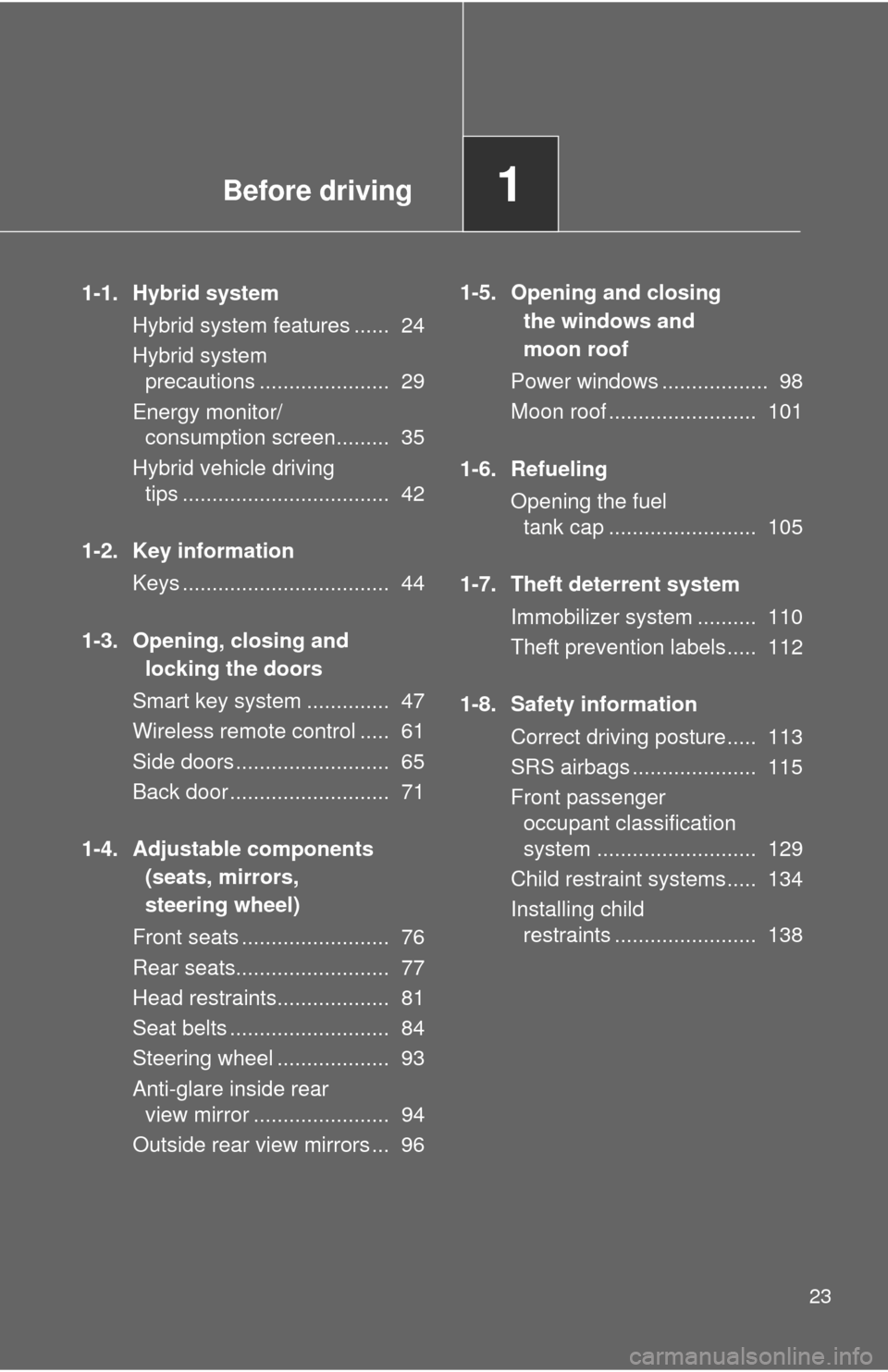
Before driving1
23
1-1. Hybrid systemHybrid system features ...... 24
Hybrid system precautions ...................... 29
Energy monitor/ consumption screen......... 35
Hybrid vehicle driving tips ................................... 42
1-2. Key information Keys ................................... 44
1-3. Opening, closing and locking the doors
Smart key system .............. 47
Wireless remote control ..... 61
Side doors .......................... 65
Back door ........................... 71
1-4. Adjustable components (seats, mirrors,
steering wheel)
Front seats ......................... 76
Rear seats.......................... 77
Head restraints................... 81
Seat belts ........................... 84
Steering wheel ................... 93
Anti-glare inside rear view mirror ....................... 94
Outside rear view mirrors ... 96 1-5. Opening and closing
the windows and
moon roof
Power windows .................. 98
Moon roof ......................... 101
1-6. Refueling Opening the fuel tank cap ......................... 105
1-7. Theft deterrent system Immobilizer system .......... 110
Theft prevention labels..... 112
1-8. Safety information Correct driving posture..... 113
SRS airbags ..................... 115
Front passenger occupant classification
system ........................... 129
Child restraint systems..... 134
Installing child restraints ........................ 138
Page 33 of 552
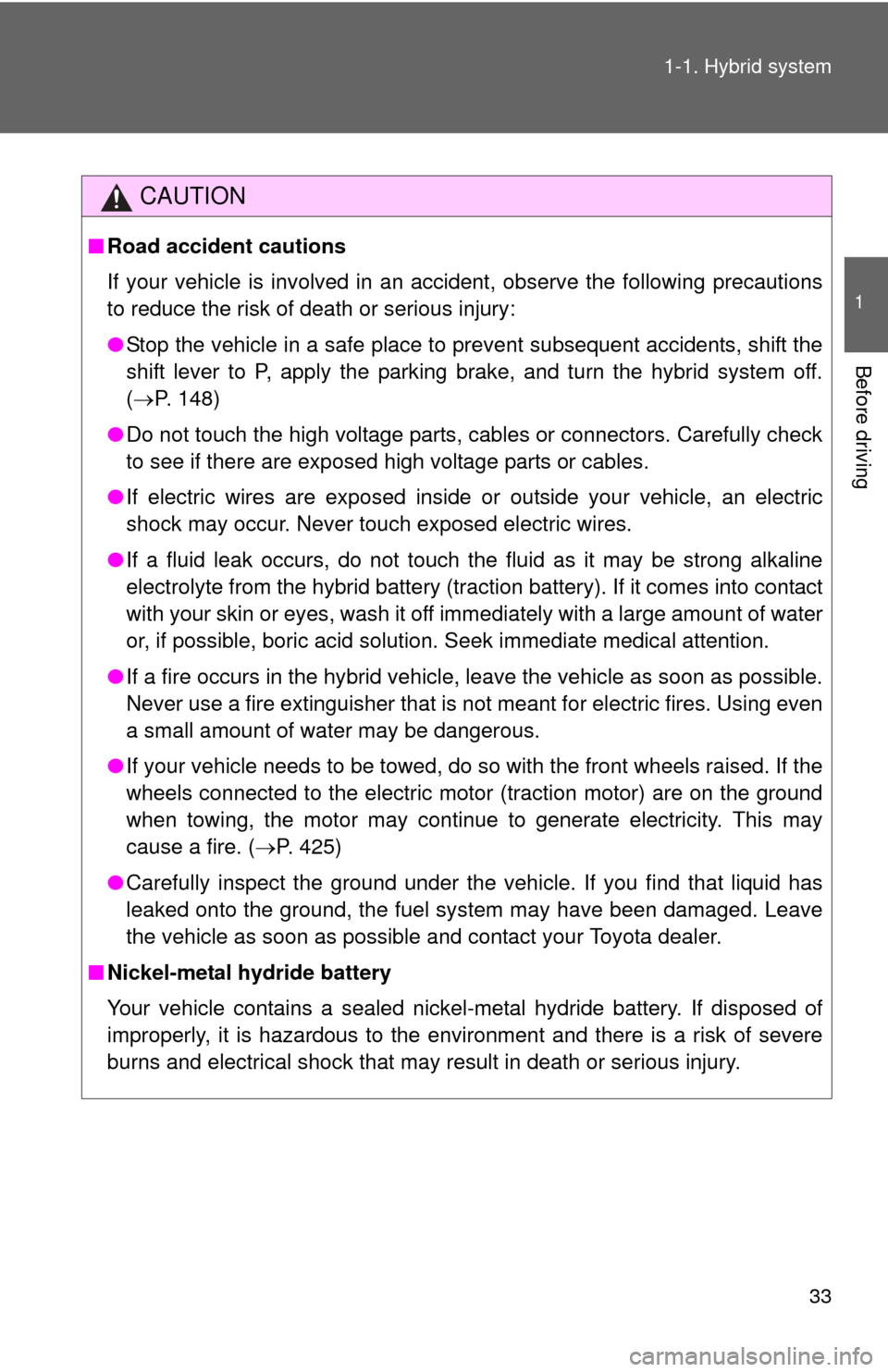
33
1-1. Hybrid system
1
Before driving
CAUTION
■
Road accident cautions
If your vehicle is involved in an accident, observe the following precautions
to reduce the risk of death or serious injury:
●Stop the vehicle in a safe place to prevent subsequent accidents, shift the
shift lever to P, apply the parking brake, and turn the hybrid system off.
( P. 148)
● Do not touch the high voltage parts, cables or connectors. Carefully check
to see if there are exposed high voltage parts or cables.
● If electric wires are exposed inside or outside your vehicle, an electric
shock may occur. Never touch exposed electric wires.
● If a fluid leak occurs, do not touch the fluid as it may be strong alkaline
electrolyte from the hybrid battery (traction battery). If it comes into contact
with your skin or eyes, wash it off immediately with a large amount of water
or, if possible, boric acid solution. Seek immediate medical attention.
● If a fire occurs in the hybrid vehicle, leave the vehicle as soon as possible.
Never use a fire extinguisher that is not meant for electric fires. Using even
a small amount of water may be dangerous.
● If your vehicle needs to be towed, do so with the front wheels raised. If the
wheels connected to the electric motor (traction motor) are on the ground
when towing, the motor may continue to generate electricity. This may
cause a fire. ( P. 425)
● Carefully inspect the ground under the vehicle. If you find that liquid has
leaked onto the ground, the fuel system may have been damaged. Leave
the vehicle as soon as possible and contact your Toyota dealer.
■ Nickel-metal hydride battery
Your vehicle contains a sealed nickel-metal hydride battery. If disposed of
improperly, it is hazardous to the environment and there is a risk of severe
burns and electrical shock that may result in death or serious injury.
Page 76 of 552
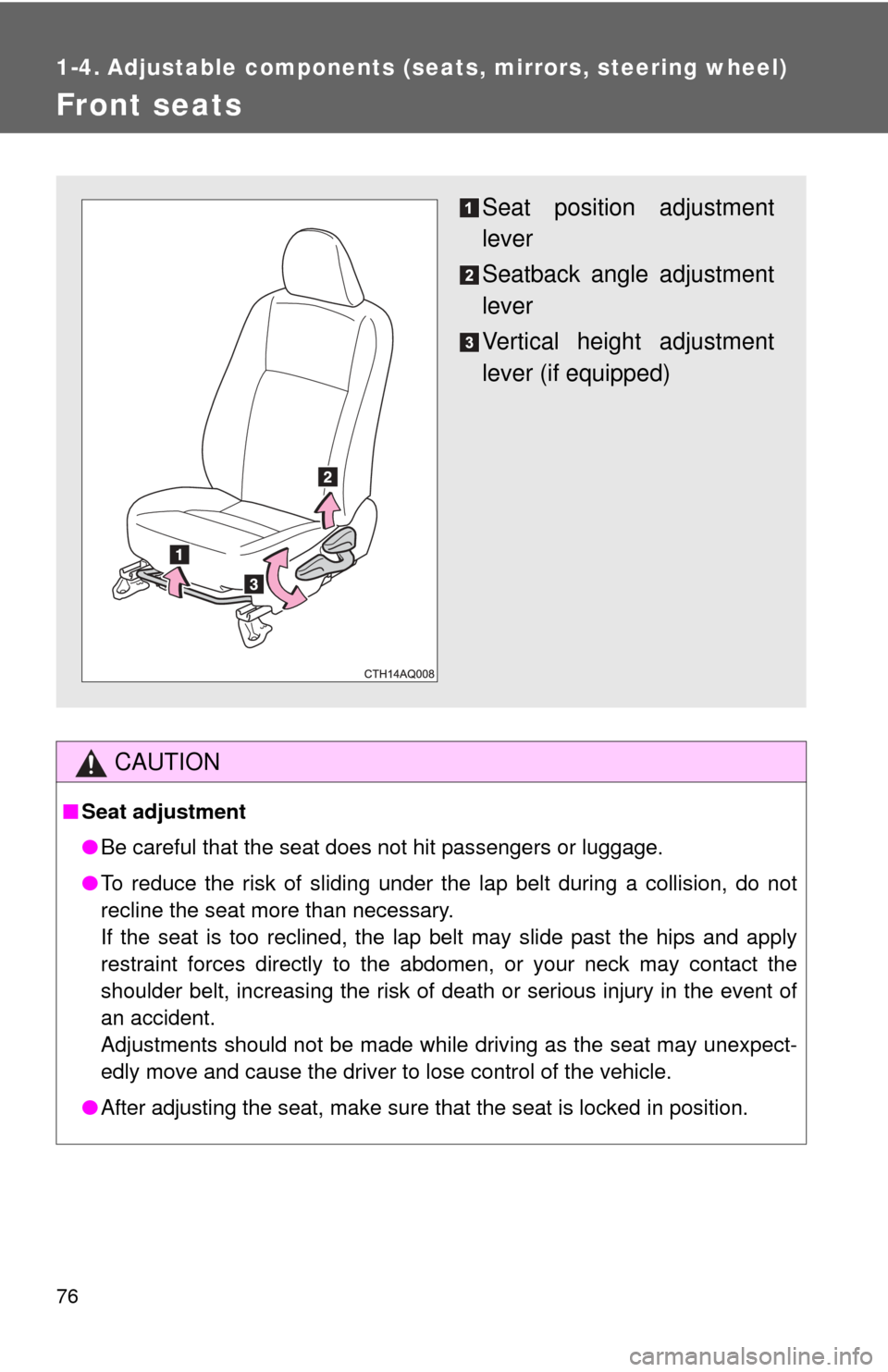
76
1-4. Adjustable components (seats, mirrors, steering wheel)
Front seats
CAUTION
■Seat adjustment
●Be careful that the seat does not hit passengers or luggage.
● To reduce the risk of sliding under the lap belt during a collision, do not
recline the seat more than necessary.
If the seat is too reclined, the lap belt may slide past the hips and apply
restraint forces directly to the abdomen, or your neck may contact the
shoulder belt, increasing the risk of death or serious injury in the event of
an accident.
Adjustments should not be made while driving as the seat may unexpect-
edly move and cause the driver to lose control of the vehicle.
● After adjusting the seat, make sure that the seat is locked in position.
Seat position adjustment
lever
Seatback angle adjustment
lever
Vertical height adjustment
lever (if equipped)
Page 79 of 552
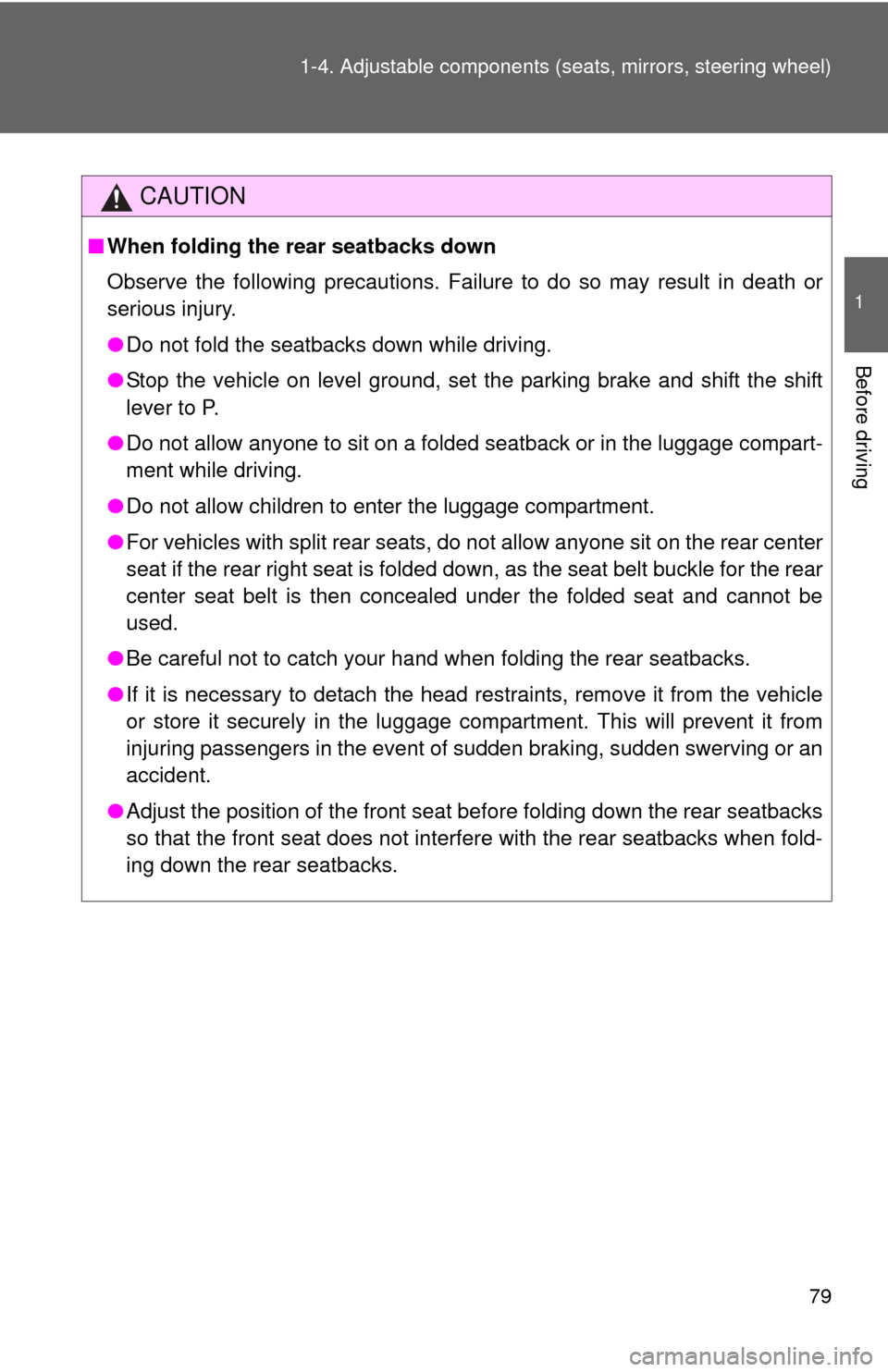
79
1-4. Adjustable components (s
eats, mirrors, steering wheel)
1
Before driving
CAUTION
■When folding the rear seatbacks down
Observe the following precautions. Failure to do so may result in death or
serious injury.
●Do not fold the seatbacks down while driving.
● Stop the vehicle on level ground, set the parking brake and shift the shift
lever to P.
● Do not allow anyone to sit on a folded seatback or in the luggage compart-
ment while driving.
● Do not allow children to enter the luggage compartment.
● For vehicles with split rear seats, do not allow anyone sit on the rear center
seat if the rear right seat is folded down, as the seat belt buckle for \
the rear
center seat belt is then concealed under the folded seat and cannot be
used.
● Be careful not to catch your hand when folding the rear seatbacks.
● If it is necessary to detach the head restraints, remove it from the vehicle
or store it securely in the luggage compartment. This will prevent it from
injuring passengers in the event of sudden braking, sudden swerving or an
accident.
● Adjust the position of the front seat before folding down the rear seatbacks
so that the front seat does not interfere with the rear seatbacks when fold-
ing down the rear seatbacks.
Page 81 of 552
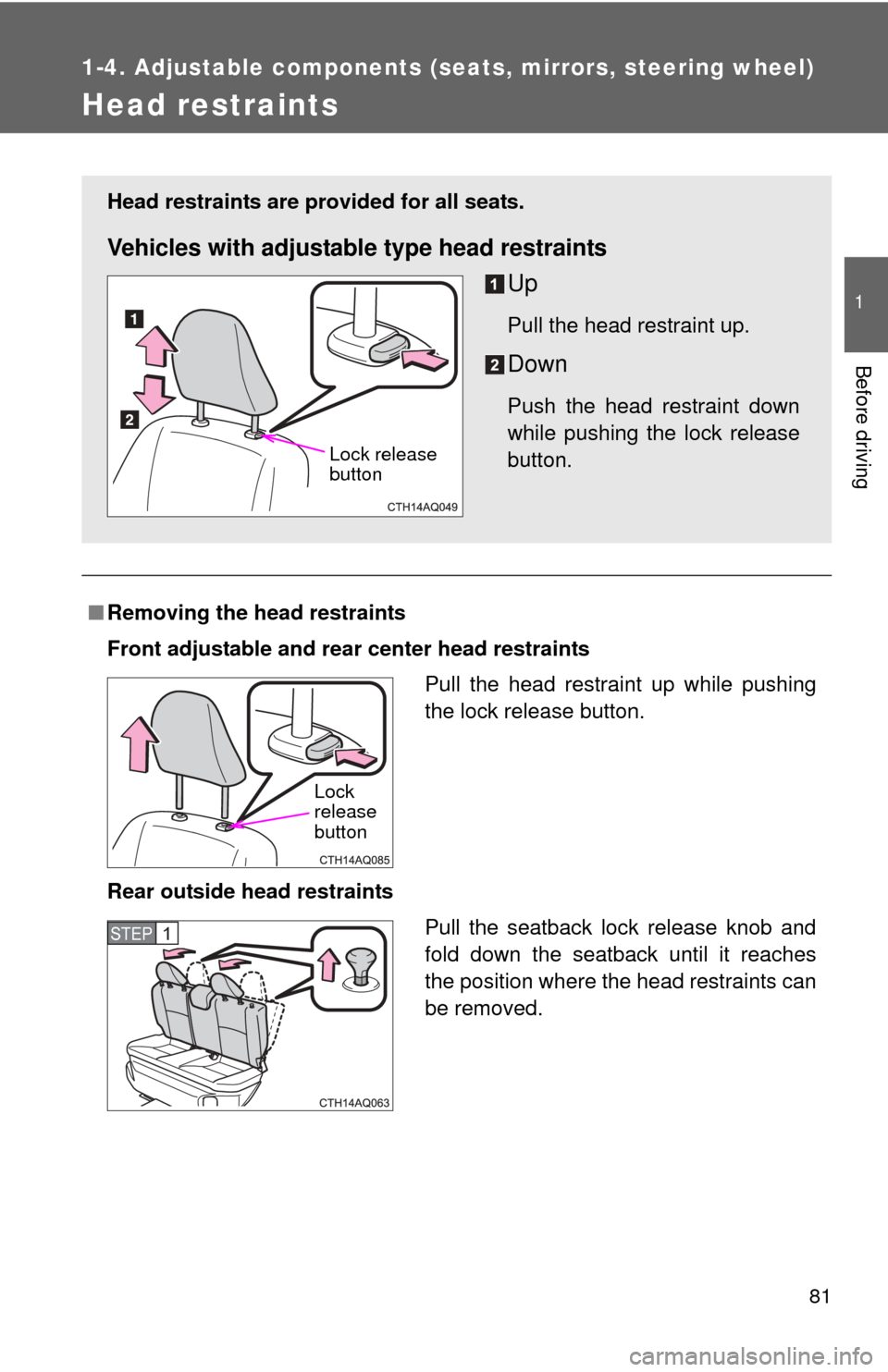
81
1
1-4. Adjustable components (seats, mirrors, steering wheel)
Before driving
Head restraints
■Removing the head restraints
Front adjustable and rear center head restraints
Rear outside head restraints
Head restraints are provided for all seats.
Vehicles with adjustable type head restraints Up
Pull the head restraint up.
Down
Push the head restraint down
while pushing the lock release
button.
Lock release
button
Pull the head restraint up while pushing
the lock release button.
Lock
release
button
Pull the seatback lock release knob and
fold down the seatback until it reaches
the position where the head restraints can
be removed.STEP1
Page 82 of 552
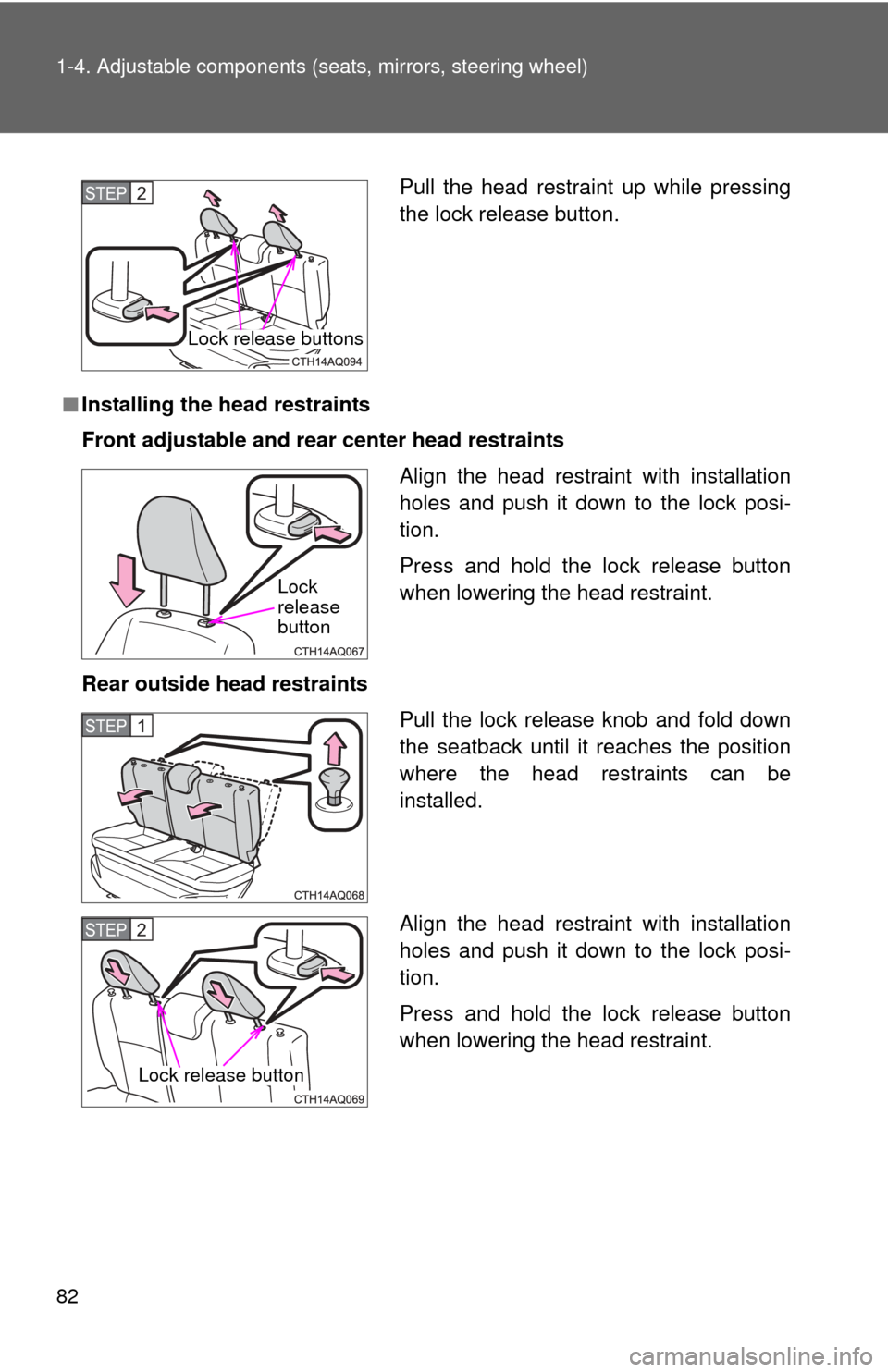
82 1-4. Adjustable components (seats, mirrors, steering wheel)
■Installing the head restraints
Front adjustable and rear center head restraints
Rear outside head restraints
Pull the head restraint up while pressing
the lock release button.STEP2
Lock release buttons
Align the head restraint with installation
holes and push it down to the lock posi-
tion.
Press and hold the lock release button
when lowering the head restraint.
Lock
release
button
Pull the lock release knob and fold down
the seatback until it reaches the position
where the head restraints can be
installed.
Align the head restraint with installation
holes and push it down to the lock posi-
tion.
Press and hold the lock release button
when lowering the head restraint.STEP1
STEP2
Lock release button
Page 88 of 552
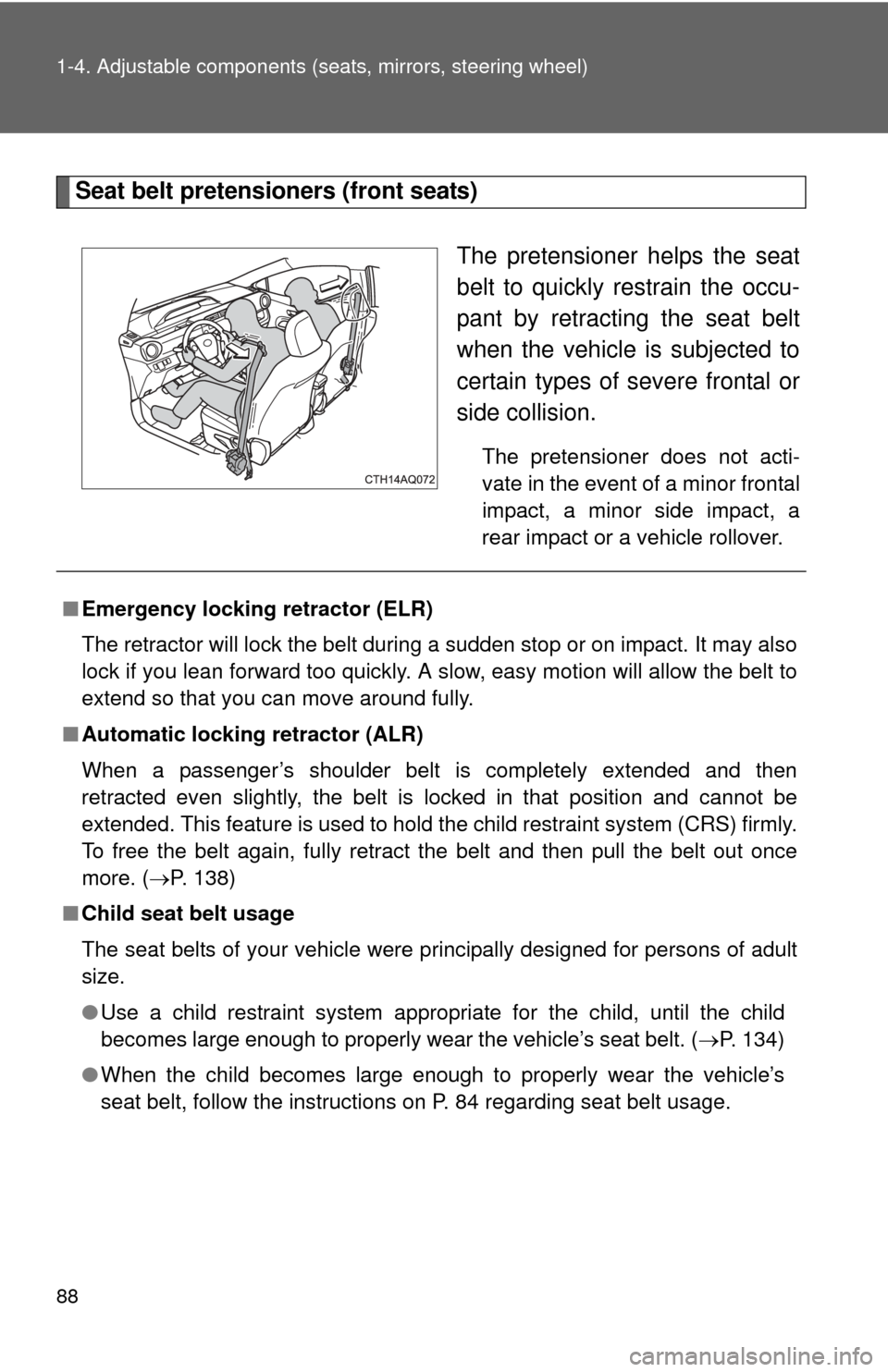
88 1-4. Adjustable components (seats, mirrors, steering wheel)
Seat belt pretensioners (front seats)
The pretensioner helps the seat
belt to quickly restrain the occu-
pant by retracting the seat belt
when the vehicle is subjected to
certain types of severe frontal or
side collision.
The pretensioner does not acti-
vate in the event of a minor frontal
impact, a minor side impact, a
rear impact or a vehicle rollover.
■Emergency locking retractor (ELR)
The retractor will lock the belt during a sudden stop or on impact. It may also
lock if you lean forward too quickly. A slow, easy motion will allow the belt to
extend so that you can move around fully.
■ Automatic locking retractor (ALR)
When a passenger’s shoulder belt is completely extended and then
retracted even slightly, the belt is locked in that position and cannot be
extended. This feature is used to hold the child restraint system (CRS) firmly.
To free the belt again, fully retract the belt and then pull the belt out once
more. ( P. 138)
■ Child seat belt usage
The seat belts of your vehicle were principally designed for persons of adult
size.
●Use a child restraint system appropriate for the child, until the child
becomes large enough to properly wear the vehicle’s seat belt. ( P. 134)
● When the child becomes large enough to properly wear the vehicle’s
seat belt, follow the instructions on P. 84 regarding seat belt usage.
Page 90 of 552
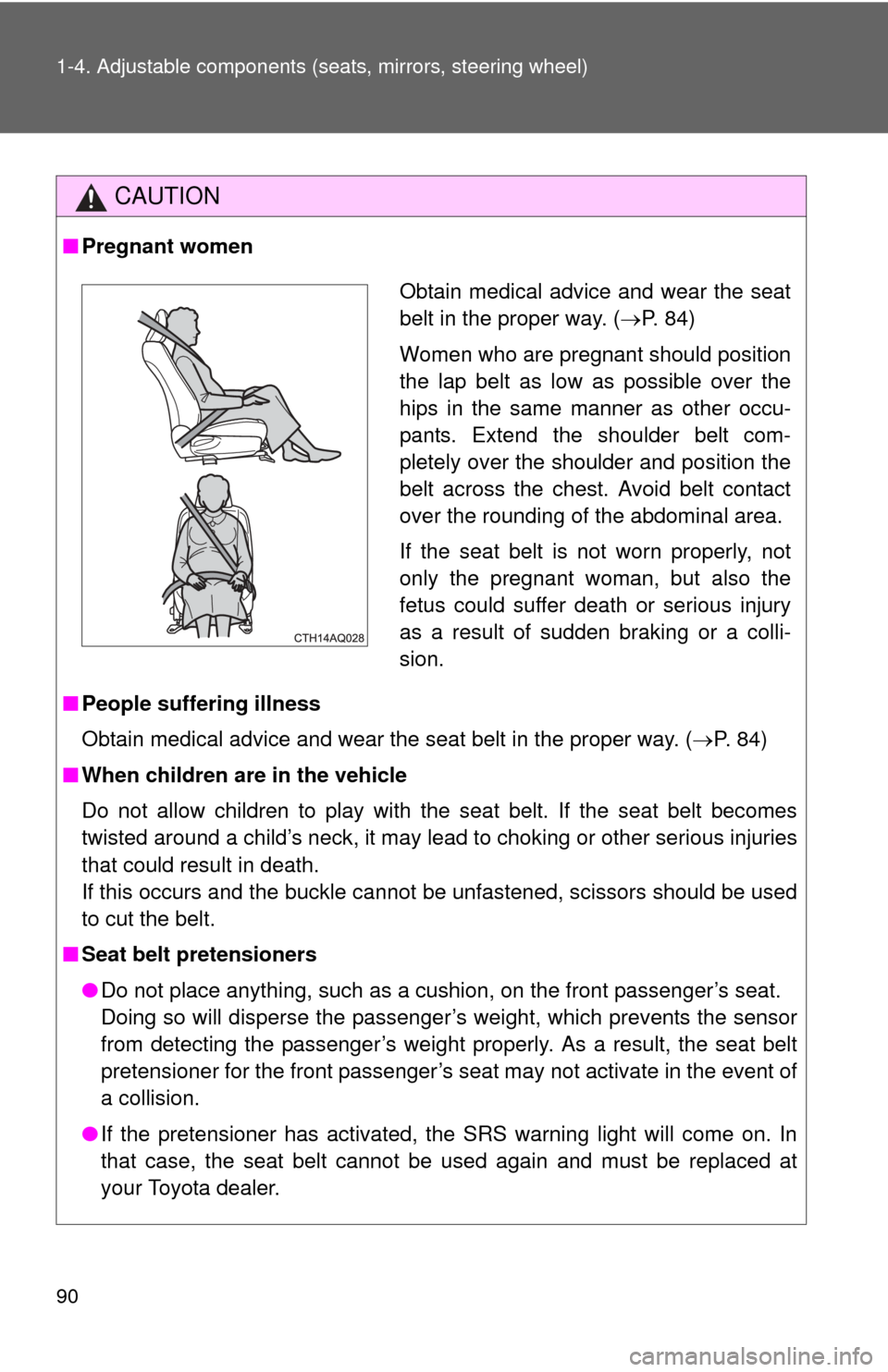
90 1-4. Adjustable components (seats, mirrors, steering wheel)
CAUTION
■Pregnant women
■ People suffering illness
Obtain medical advice and wear the seat belt in the proper way. ( P. 84)
■ When children are in the vehicle
Do not allow children to play with the seat belt. If the seat belt becomes
twisted around a child’s neck, it may lead to choking or other serious injuries
that could result in death.
If this occurs and the buckle cannot be unfastened, scissors should be used
to cut the belt.
■ Seat belt pretensioners
●Do not place anything, such as a cushion, on the front passenger’s seat.
Doing so will disperse the passenger’s weight, which prevents the sensor
from detecting the passenger’s weight properly. As a result, the seat belt
pretensioner for the front passenger’s seat may not activate in the event of
a collision.
● If the pretensioner has activated, the SRS warning light will come on. In
that case, the seat belt cannot be used again and must be replaced at
your Toyota dealer.
Obtain medical advice and wear the seat
belt in the proper way. ( P. 84)
Women who are pregnant should position
the lap belt as low as possible over the
hips in the same manner as other occu-
pants. Extend the shoulder belt com-
pletely over the shoulder and position the
belt across the chest. Avoid belt contact
over the rounding of the abdominal area.
If the seat belt is not worn properly, not
only the pregnant woman, but also the
fetus could suffer death or serious injury
as a result of sudden braking or a colli-
sion.
Page 119 of 552

119
1-8. Safety information
1
Before driving
■
If the SRS airbags deploy (inflate)
●Bruising and slight abrasions may result from contact with a deploying
(inflating) SRS airbag.
● A loud noise and white powder will be emitted.
● Parts of the airbag module (steering wheel hub, airbag cover and inflator)
as well as the front seats, parts of the front and rear pillars, and roof side
rails, may be hot for several minutes. The airbag itself may also be hot.
● The windshield may crack.
■ SRS airbag deployment conditions (SRS front airbags/SRS seat cush-
ion airbags)
● The SRS front airbags and SRS seat cushion airbags will deploy in the
event of an impact that exceeds the set threshold level (the level of force
corresponding to an approximately 12 - 18 mph [20 - 30 km/h] frontal col-
lision with a fixed wall that does not move or deform).
However, this threshold velocity will be considerably higher in the following
situations:
• If the vehicle strikes an object, such as a parked vehicle or sigh pole,
which can move or deform on impact
• If the vehicle is involved in an underride collision, such as a collision in which the front of the vehicle “underrides”, or goes under, the bed of a
truck
● Depending on the type of collision, it is possible that only the seat belt
pretensioners will activate.
● The SRS front airbags and seat cushion airbag for the front passenger
will not activate if there is no passenger sitting in the front passenger
seat. However, the SRS front airbags and seat cushion airbag for the
front passenger may deploy if luggage is put in the seat, even if the seat
is unoccupied.
● The SRS seat cushion airbags on the front seats will not operate if the
occupant is not wearing a seat belt.